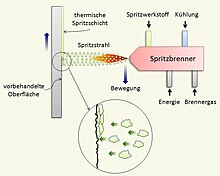Thermal spray
The method of thermal spraying are surface coating method . According to the normative definition (DIN EN 657), filler materials, the so-called spray additives, are melted, partially or melted inside or outside a spray gun, accelerated in a gas flow in the form of spray particles and thrown onto the surface of the component to be coated . The component surface is not melted (in contrast to build-up welding ) and is only thermally stressed to a small extent. A layer formation takes place because the spray particles flatten more or less depending on the process and material when they hit the component surface, stick primarily through mechanical interlocking and build up the spray layer in layers. Quality features of spray coatings are low porosity , good connection to the component, freedom from cracks and homogeneous microstructure. The layer properties achieved are significantly influenced by the temperature and the speed of the spray particles at the time they hit the surface to be coated. The surface condition (purity, activation, temperature) also has a decisive influence on quality features such as adhesive strength.
Electric arcs (arc spraying), plasma jets (plasma spraying), fuel-oxygen flames or fuel-oxygen high-speed flames (conventional and high-speed flame spraying), fast, preheated gases (cold gas spraying), etc. serve as energy carriers for melting or melting the additional spray material Laser beam (laser beam spraying). According to DIN standard EN 657, the spraying processes are classified according to these criteria.
The purpose of this process is the coating of metallic and non-metallic materials with metals , oxide-ceramic materials and carbidic materials (or composite materials in general) for the purpose of changing and specifically adapting surface properties. Important branches of industry in which thermally sprayed coatings are used are the automotive industry, the paper and printing industry, the aerospace industry, the waste industry, the energy-generating industry and general mechanical and plant engineering. The main fields of application are (combined) wear and corrosion protection, protection against hot gas corrosion, thermal insulation or the adaptation of friction and sliding properties.
Thermal spray processes
- Weld pool spraying
- Arc spraying (wire arc spraying)
-
Plasma spraying
- of atmosphere
- under protective gas
- under low pressure (vacuum)
-
Flame spraying
- Powder flame spraying
- Wire flame spraying
- Plastic flame spraying
-
High speed flame spraying
- with gaseous fuel
- with liquid fuel
- Detonation spraying (flame shock spraying)
- Cold gas spraying
- Laser spraying
- PTWA spraying (internal coating, PTWA = Plasma Transferred Wire Arc )

